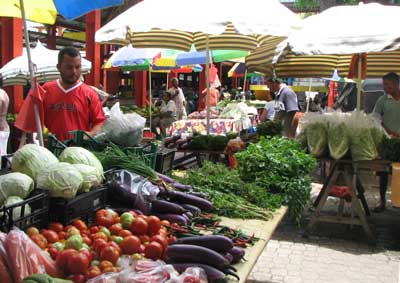High cost of imported food threatens nutrition security
MINISTER of Agriculture, Dr. Leslie Ramsammy has warned that the high cost of importing food into Caribbean Community (CARICOM) countries is a threat also to nutrition security in the Region.In an interview with the Guyana Chronicle, he said: “Together with the high cost of energy and climate change, the high food importation bill stands as a major threat to sustaining food and nutrition security in CARICOM

countries and leave our countries very exposed and vulnerable to price increases and production shifts.”
According to him, CARICOM needs to address this issue with urgency and treat the matter as a crisis situation.
He pointed out that, just as the Region is vulnerable to price increases in oil, it is threatened by price increases and the uncertainty of agriculture production from the supplying countries.
Citing corn as an example, Ramsammy posited:“When corn production fell in the USA and Russia in 2012/2013, the increases in corn prices affected prices in other areas, such as cost of meat and dairy products.
“…the Region spends about US$200M on corn importation. Guyana imports about US$12M worth of corn each year. Jamaica, with importation of about US$83M per year is the Region’s largest importer of corn.”
He continued that, in 2013, CARICOM countries imported more than US$5.1B in food, with The Bahamas, Jamaica and Trinidad and Tobago being the biggest importers, of which the importation of onions was valued at US$13M alone.
The Minister said:“In 1990, the food import bill for CARICOM countries was about US$1.3B.It surpassed US$2B by 1997. After 2002, the food import bill for Caribbean countries increased significantly and, by last year, had exceeded US$5.1B.
“The food import bills for three countries, Jamaica, Bahamas and Trinidad and Tobago amount to approximately US$1B each in 2013.
“In eight countries, per capita import bills amount to more than $500 per capita, with Suriname, Guyana and Belize at about $200 per capita at the lower end. The global average among developing countries for food importation is underUS$100 per capita,” Ramsammy related.
He pointed out that, in contrast, CARICOM’s food export in 2013 amounted to just about US$1.4B.
Not changed
“While the food import bill has grown significantly since 1990, the food export bill has not changed much since 1990. In 1990, the food export amounted to about US$0.9B. Last year, food export rose to only US$1.4B. This means that, while the food import bill last year was about 400 percent higher than 1990, the food export remains relatively stagnant since 1990,” Ramsammy said.
He reported that a large amount of processed and canned food is imported into CARICOM, including items such as ketchup, jams, sauces and soups, in excess of US$300M per year and represent the number one ranked commodities imported into CARICOM countries.
Ramsammy said:“Also high on the list and ranked number two is the importation of wheat for the production of flour.
“CARICOM countries imported almost US$300M of wheat each year. Guyana imports about US$24M wheat each year for the production of flour. The largest importers of wheat in CARICOM are Jamaica $US73M, Haiti with US$62M and Trinidad and Tobago US$49M.
“While Guyana and Belize could be satisfied that they, generally, are self-sufficient in poultry meat, other CARICOM countries imported more than US$250M in poultry meat in 2012. The largest importers of poultry meat are Haiti withUS$71M, The Bahamas with US$36M, Jamaica and Trinidad and Tobago with US$30M each and Suriname with US$22M.”
The Agriculture Minister stated, too, that CARICOM countries have become dependent on imported milk for food security, importing up to US$200M annually.
“Guyana spends about US$25M, Trinidad and Tobago more than US$42M and Barbados and Jamaica about US$10M each per year importing milk. For Guyana, milk is the largest food import for the country,” he said.
“CARICOM countries imported, mainly from the U.S., almost US$50M worth of vegetables per year. Imports include more than US$13M of onions, annually, more than US$8M of carrots, more than US$5M of lettuce, more than US$3M of broccoli and cauliflower and more than US$3M of tomatoes.”
Hefty appetite
He posited that the Region’s nationals have a hefty appetite for imported food while, at the same time, the need for the massive importation of certain foods are unnecessary.
At the local level, the Minister said Government has a legitimate role in promoting our local products.
“How we do so will be a challenge in the new world of trade liberalisation, but we do produce high quality nutritious food and we must create a demand for our food, not by limiting what could come to Guyana, but by creating a preference for our food.
“We must not ban food products. It is an option we once tried. But preference for locally made plantain chips, pepper sauce etc. will reduce import of these products.”
Ramsammy concluded that action must be taken to address what is an increasingly growing problem and action must be taken with a matter of urgency.
(By Vanessa Narine)



.jpg)









